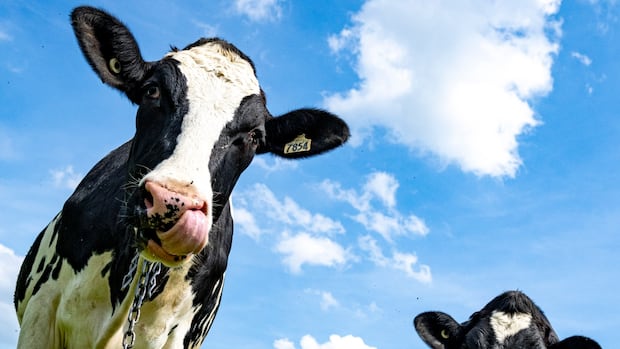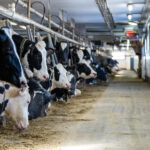Article – I stepped off a small dairy farm in Wisconsin last week, my notebook filled with more frustration than facts. Fifth-generation farmer Dave Heintz had just shown me his operation – 120 Holstein cows, the computerized milking parlor he’d invested in five years ago, and the financial statements showing his narrowing path to survival.
“We’re getting squeezed from every direction, and Canada’s supply management system has become this perfect villain in our story,” Heintz told me, leaning against a feed trough. “But the truth? This is about way more than Canada.”
The renewed American focus on Canadian dairy markets comes as President-elect Donald Trump promises sweeping 10-25% tariffs on all Canadian imports. This latest chapter in the perennial trade dispute arrives just as U.S. dairy farmers face their worst profitability crisis in decades, with milk prices hovering near production costs and farm bankruptcies continuing at alarming rates across America’s dairyland.
Canada’s supply management system, which strictly controls dairy production and imports through quotas while ensuring stable prices for farmers, has long been a target of U.S. trade negotiators. Under the system, Canadian dairy farmers receive consistently higher prices than their American counterparts – a reality that has fueled resentment across the northern border states where dairy operations are concentrated.
“The frustration is understandable,” says Sophia Martinez, agricultural economist at the University of Minnesota. “When American dairy farmers are getting $21 per hundredweight and their Canadian neighbors are receiving nearly $30 for essentially the same product, that disparity becomes politically explosive.”
But the economics tell a more complex story. U.S. dairy production has increased by nearly 15% in the last decade despite stagnant domestic consumption, according to USDA figures. This overproduction crisis has driven down prices across the American industry, a problem that access to Canada’s protected market – representing just 2% of potential U.S. dairy exports – cannot solve.
During the negotiation of the United States-Mexico-Canada Agreement (USMCA) in 2018, Canada did make concessions, opening approximately 3.6% of its dairy market to U.S. imports. But American industry groups like the National Milk Producers Federation argue these openings remain insufficient and that Canada has used regulatory tactics to undermine even this limited access.
“Canada agreed to eliminate Class 7 pricing under USMCA, which was designed to undercut U.S. exports of milk protein concentrates,” explains Jim Mulhern, president of the National Milk Producers Federation. “But they’ve essentially replaced it with a new system that achieves the same protectionist results through different mechanisms.”
In Ottawa, I found Canadian officials and industry representatives holding firm. “Supply management isn’t just an economic program – it’s the backbone of rural communities across our country,” said Pierre Lampron, president of Dairy Farmers of Canada, when I met him at the organization’s headquarters. “Americans need to understand we’re not going to dismantle a system that works for our farmers just because U.S. producers face challenges from their own overproduction.”
The dispute reveals deeper questions about agricultural policy on both sides of the border. Canada’s system essentially treats milk as a managed resource rather than a pure commodity, controlling supply to match demand while providing farmers with predictable returns. American policy, meanwhile, has encouraged maximum production with minimal market coordination – leading to boom-bust cycles that have been devastating for small and mid-sized dairy operations.
Back in Wisconsin, I visited the shuttered remains of the Hillcrest Cooperative Creamery, once the economic center of a community now struggling with outmigration and declining school enrollment. Nearly 2,500 U.S. dairy farms closed their doors in 2023 alone, according to industry data, continuing a decades-long consolidation trend.
“Trump’s focus on Canadian dairy makes for good politics in states like Wisconsin and New York,” notes Eliza Montgomery of the Agricultural Trade Policy Institute. “But even if Canada completely opened its market tomorrow, it wouldn’t solve the structural issues in the U.S. dairy industry. We’re producing too much milk for too little return, and that’s a domestic policy failure, not a trade problem.”
The economic stakes of the dispute extend far beyond dairy. Canada is America’s largest export market, with two-way trade totaling $577 billion in 2023, according to U.S. Commerce Department figures. Manufacturing supply chains in sectors from automotive to aerospace are deeply integrated across the border, raising concerns that new tariffs could disrupt production and raise consumer prices in both countries.
“This is classic displacement of blame,” says Manuel Rodriguez, who researches agricultural economics at Georgetown University. “It’s easier for politicians to point fingers at foreign trade partners than to acknowledge that domestic agricultural policies have created unsustainable conditions for family farmers.”
As President-elect Trump prepares to take office in January, Canadian officials are quietly preparing contingency plans for potential retaliatory measures if new tariffs materialize. The last major trade dispute between the countries – over steel and aluminum tariffs imposed by the Trump administration in 2018 – resulted in Canadian counter-tariffs targeting politically sensitive American products.
For farmers like Heintz in Wisconsin, the diplomatic maneuvering feels distant from his immediate reality. “I’ve got loan payments due on equipment I bought when milk prices were higher,” he tells me as we walk past a row of cattle. “Whether Canada opens up tomorrow or not, that doesn’t change.”
As our interview concludes, Heintz shows me photographs of his grandfather working the same land in the 1950s. “He never worried about Canadian trade policy,” Heintz says with a tired smile. “But he also never had to milk 120 cows just to stay afloat.”






